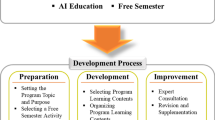Abstract
In 1999 Technology in the New Zealand Curriculum became mandatory. It was developed over a period of approximately four years from conception to publication, with wide consultation. It was first published in October 1995. During the three years between publication and gazetting many teachers were involved in professional development. During this time it became obvious that there was confusion amongst teachers about the meaning of `authenticity' in relation to technology programmes. Do technological problems need to be authentic to the students themselves or to the nature of technological practice? Many learning theories have informed the development of this document. Those selected here indicate quite clearly the meaning and context of authenticity with regard to technology education. By involving our students in activity that is authentic to technological practice or real world technology, teachers are able to provide stimulating and relevant learning for students. This was also the indication in recent communication from the Ministry of Education in New Zealand during the 1999 Technology Education New Zealand (TENZ) conference.
By giving academic value to technology and developing our teachers in the fields of technological practice we hope our students will influence the economic status of our country in the future.
Similar content being viewed by others
REFERENCES
Alton-Lee, A. & Densem, P.: 1992,‘Towards Gender-Inclusive School Curriculum, Changing Educational Practice’ in S. Middleton & A. Jones (eds.), Women and Education in Aotearoa 2, Bridget Williams Books, Wellington.
Atkinson, S.: 1999,‘Key Factors Influencing Pupil Motivation in Design and Technology’ Journal of Technology Education 10(2), Spring.
Bereiter, C.: 1992,‘Referent-Centered and Problem-Centred Knowledge: Elements of an Educational Epistemology’ Interchange 23(4), 337–361.
Brown, J., Collins, A. & Duguid, P.: 1989,‘Situated Cognition and the Culture of Learning’ Education Researcher 18(1), 32–42.
Brown, M., Benson, S. & Ferguson, D.: 1999,‘Development of Technology Education in New Zealand’ Unpublished paper, 30 September 1999, Wellington.
Burns, J. (ed.): 1996, Technology in the New Zealand Curriculum: Perspectives on Practice, Dunmore Press, Palmerston North, 1997, 46–59.
Compton, V., Harwood, C. & Northover, A.: 2000,‘Technology Education Assessment: National Professional Development’ Unpublished paper prepared by Milestone Four and LITE (Assessment) 1999 for the Ministry of Education, Wellington.
Creech, W.: 1997,‘Launch of "Towards Teaching Technology": Know How I’ Unpublished speech, Auckland.
Ferguson, D.: 1991, Papers for circulation within the Ministry of Education and beyond, unpublished, Wellington.
Guy, T.: 1992,‘Resources and Facilities for Technology Education’ Unpublished paper, Wellington.
Hennessy, S.: 1993,‘Situated Cognition and Cognition Apprenticeship: Implications for Classroom Learning’ Studies in Science Education 22, 1–41.
Hennessy, S. & Murphy, P.: 1999,‘The Potential for Collaborative Problem Solving in Design and Technology’ International Journal of Technology and Design Education 9(1), 1–36.
Hill, A. M.: 1997,‘Reconstructivism in Technology Education’ International Journal of Technology and Design Education 7(1/2), 121–139.
Hill, A. M.: 1998,‘Problem Solving in Real Life Contexts: Alternatives for Design in Technology Education’ International Journal of Technology and Design 8(3), 203–220.
Hill, A. M. & Smith, H. A.: 1998,‘Practice Meets Theory in Technology Education: A Case of Authentic Learning in a High School Setting’ Journal of Technology 9(2), Spring.
Johnson, S. D.: 1992,‘A Framework for Technology Education Curricula which Emphasises Intellectual Processes’ Journal of Technology Education 3(2), Spring.
Jones, A.: 1991,‘Technology Education Policy Papers’ Unpublished papers for circulation within the Ministry of Education and beyond, Wellington.
Jones, A.: 1996,‘Recent Research in Learning Technological Concepts and Processes’ Unpublished paper presented at The Second Jerusalem International Science and Technology Education, January 8–11, Jerusalem.
Jones, A. & Carr, M.: 1993,‘Towards Technology Education Vol. 1’ Working papers from the first phase of the Learning in Technology Education Project, University of Waikato, Hamilton.
Lave, J.: 1991,‘Situated Learning in Communities of Practice’ in L. B. Resnick, J. M. Levine & S. D. Teasley (eds.), Shared Cognition Thinking as Social Practice: Perspectives on Socially Shared Cognition, American Psychological Association, Washington, 63–82.
Lave, J.: 1992,‘Word Problems: A Microcosm of Theories of Learning’ in P. Light & G. Butterworth (eds.), Context and Cognition: Ways of Learning and Knowing, Harvester Wheatsheaf, Hemel Hempstead, 74–91.
Lave, J.: 1998, Cognition in Practice Mind, Mathematics and Culture in Everyday Life, Cambridge University Press, Cambridge.
Lewis, T.: 1999,‘Research in Technology Education: Some Areas of Need’ Journal of Technology Education 10(2), Spring.
McCormick, R.: 1997,‘Conceptual and Procedural Knowledge’ International Journal of Technology and Design Education 7, 141–159.
McLachlan-Smith, C.: 1998,‘Designing for Dialogue at a Distance: Reflections on How to Create and Maintain an Effective Teaching-Learning Relationship With Students’ Journal of Distance Learning 4(1), 11–22.
Maddux, C. D. & Cummings R.: 1999,‘Constructivism: Has the Term Outlived Its Usefulness?’ Computers in Schools 15(3/4), 5–20.
Medway, P.: 1989,‘Issues in the Theory and Practice of Technology Education’ Studies in Science Education 16, 1–24.
Ministry of Education: 1995, Technology in the New Zealand Curriculum, Learning Media, Wellington.
Ministry of Education: 1999, Education Gazette 78(21), Learning Media, Wellington.
Rogoff, B.: 1990, Apprenticeship in Thinking: Cognitive Development in Social Context, Oxford University Press, New York.
Smith, N.: 1999, Pathways to Technological Literacy: Conference Proceedings, Telecom Technology Education Conference, April 14–16, Auckland.
Vygotsky, L. S.: 1978‘Mind in Society: The Development of Higher Psychological Processes’ in M. Cole, V. John-Steiner, S Scribner & E. Souberman (eds.), Harvard University Press, London, 19–119.
Wajcman, J.: 1991, Feminism Confronts Technology, Allen and Unwin, Sydney.
Zuga, K.: 1992,‘Social Reconstruction: Curriculum and Technology Education’ Journal of Technology Education 3(2), Spring.
Zuga, K.: 1999,‘Addressing Women's Ways of Knowing to Improve Technology Education Environment for All Students’ Journal of Technology Education 10(2), Spring.
Author information
Authors and Affiliations
Rights and permissions
About this article
Cite this article
Turnbull, W. The Place of Authenticity in Technology in the New Zealand Curriculum. International Journal of Technology and Design Education 12, 23–40 (2002). https://doi.org/10.1023/A:1013056129283
Issue Date:
DOI: https://doi.org/10.1023/A:1013056129283




